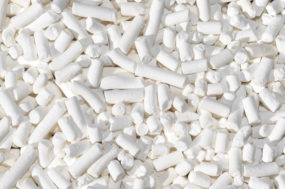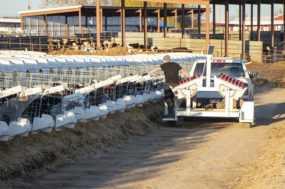Like something from a science fiction movie, cows are now bringing themselves to the barn and being milked, with no farmer needed. Thanks to robotic milking machines, today's dairy farmer is no longer tied to the parlor.
Even smaller dairies are quickly adapting to robots doing the milking. And many of these are doing so in pasture-based systems. Grazing dairies, more so than those without pasture access, have a few additional complications to work out when implementing a robotic milking system. Somehow, the cows have to be enticed back into the barn, from the pastures, for milking, and then directed back to the proper field to continue their rotational grazing.
Pasture and robots
"The toughest part of having robots is grazing," Chuck Deichmann of Willow Creek Farm in Belmont, New York, says.
Deichmann has had to do his homework. His dairy was among the first to use robots in a grazing dairy system – as well as one of the first organic dairies to use robots – in the U.S. He had to first convince his processor, Horizon Organics, that robotics could fit with an organic grazing dairy system.
Willow Creek Farm has been using a robotic milking system since 2007. They now have two robots and have been able to increase the number of heifers they can manage, as the robots allow them time away from milking to focus on other aspects of the dairy.
The toughest challenge Deichmann has faced in implementing a robotic milking system is managing cow flow from pasture, he says. "How do you milk one cow at a time and get 70 cows out to pasture?"
In Deichmann's system, cows come and go as they please to the robot, and the robot decides whether or not a cow gets milked. Once milked, however, the cow is pushed outside to pasture, via a one-way gate. But if a cow tries to leave the barn without being milked, and it is within a certain time range since her last milking, she won't be allowed through the gate to exit to pasture until she goes to the robot for milking.
The cows are rotated into new pasture every 12 hours. In the winter, when the pastures are closer to the barn, cows milk about three times per day. In the warmer weather, the pastures are up to one-half mile away, and the cows' milking frequency drops to about two and a half times per day on average.
Virginia Chamberlain is the manager at the Alfred State College Farm, overseeing a herd of Holstein crosses, with a sand-bedded freestall barn. A DeLaval robot has been in use since 2012. The 2014 grazing season was the first full season with the robot in use and cows on pasture.
The cows at Alfred State are provided corn silage, haylage and a total mixed ration as well as pasture, receiving eight pounds of supplemental grain per day on average. The average herd somatic cell count is between 50,000 and 80,000, and the cows average 70 pounds of milk per day.
At Paul Tillotson's Cottonwood Dairy in Pavillion, New York, the 950 acres is home to pasture for the 300-cow herd and hay fields. He has only had robots for one year, and establishing a system that controls how the cows move in and out of pasture, while getting them all milked, was a big challenge. But with an investment in five robots, it had to work.
Tillotson hired a consultant to help develop three grazeways, which allow the cows to go to and from the barn to the pastures. Each grazeway has two lanes. If a cow that hasn't been milked attempts to move along the grazeways, she will be diverted automatically to the barn.
"We're learning what we need to do differently in order to make everything work," he says.
He has reduced his pasture from 65 percent of intake to 50 percent during the adjustment period, increasing the baleage fed, but he is working to bring it back up now that the cows have acclimated to returning to the barn from the pasture. The baleage was used to get the cows to come back into the barn. Grain pellets entice the cows into the robot for milking.
The cows have adapted well to individual milking, and most milk three or four times each day. A few weeks were needed to break up the "herd mentality," he says. About one-sixth of his milking herd of 120 cows initially would not come back at night to milk. They now tend to come back one or two at a time in the dark.
Management
At Alfred State College Farm, pushing cows to and from pasture is challenging, Chamberlain says. The cows like the pasture, and they like the stalls, but they don't want to move back and forth between the two. With 25 paddocks permanently fenced, the cows are rotated to fresh pasture every 12 hours. The 60 milking cows pass through a sort gate at the barn, being directed into the robot if they need milking or into a feed pen if not. They average two and a half visits to the robot per day.
It is amazing "how calm a heifer is in the robot" and how quickly they train to the robotic milking system, Chamberlain says. The college also has a milking parlor, and it is a "change in thinking" from managing a parlor system to managing a robotic system.
"It's really changed how I manage cows," Tillotson says, and the robotic system allows the dairy to keep labor needs low, with only three full-time employees.
Each dairy has its own unique operating needs, and the robotic system can be customized to reflect those concerns. Tillotson will be updating his software to help control the 30 gallons of milk he pulls each day for the calves. Diechmann uses a buffer tank so cows can still milk when the milk truck is there. Alfred State College Farm had to make some adjustments to keep the robot's computers running in a sand-bedded environment.
Establishing the robotic milking system to accommodate a grazing dairy has initial challenges. But the savings in time and labor result in an improved lifestyle, the farmers agree. Adding robotic milking has increased productivity overall at these farms.
"See as many farms as you can. Figure out what will work for your system," Deichmann recommends.
For those opting to make the switch to robotic milking, the work of the dairy farmer is evolving. PD
Deichmann, Tillotson and Chamberlain were a part of a panel discussion at the NOFA-NY Organic Dairy and Field Crop Conference, held in Syracuse, New York, last March.
Tamara Scully, a freelance writer based in northwestern New Jersey, specializes in agricultural and food system topics.






